Luke is acutely aware that, as farm help becomes harder to find, the job would be a lot more difficult and the margins tighter without the technology developments and innovation now flowing through into the industry.
He says the technology they have invested in, including an auto-drafting system and a new computerised feeding system in the dairy, is geared towards saving labour and providing data for better decision-making.
“Dad just visited a farm down near Bega and he was telling me they were milking similar numbers to us and were AI-ing [artificially inseminating] at the time. They had to have three people out there drafting cattle as they were coming out of the dairy. Dad said to me: ‘You forget how good you’ve got it’.”
RELATED ARTICLES ON DAIRY FARMING:
-
The buffalo farmers bucking tradition with cheese
-
Dairy farmers in danger of disappearing from industry
-
The dairy farmers innovating through education
-
Dairy farm thrives after deregulation
The Clearys installed an auto-drafting system when their new dairy was built 10 years ago. Now, following a technology upgrade last year, the herd can be monitored constantly. Any cows flagged in the computer system, for whatever reason, are automatically drafted out when they leave the dairy, without any human intervention.
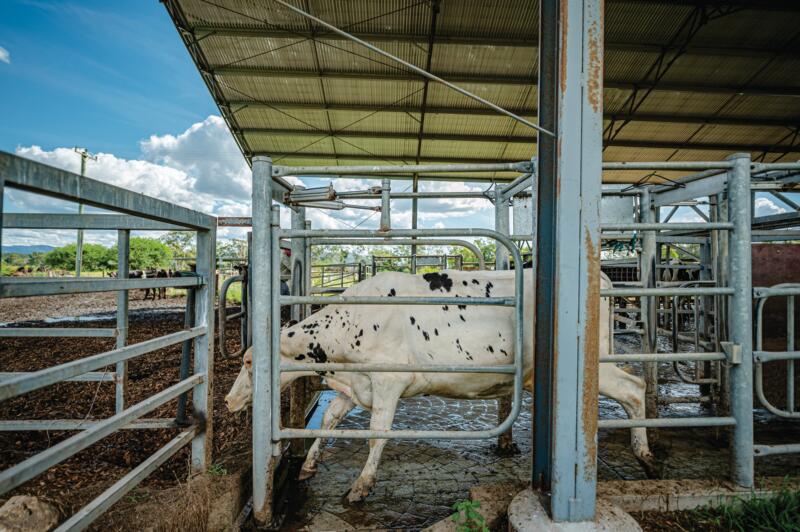 Automatic drafting pen pneumatics – this cow is not being drafted.
Automatic drafting pen pneumatics – this cow is not being drafted.
But whatever technology gets implemented, it has to pass the cost/benefit analysis. “There’s a money side to it, and the human side, and you’ve got to be mindful of both,” Luke says.
“There’s times when you might say, ‘No, I won’t put something in’, and it’s causing huge stress on labour and that can backfire on you.
RELATED: Virtual fences improve labour efficiency
“We’ve looked into programs with collars on cows [for rumination monitoring] but it’s upwards of $80,000, so at this stage we can’t see the payback.”
Pregnancy sensor lights help lift in-calf rates
One technology the Clearys have invested in to improve in-calf rates is the
Flashmate Electronic Heat Detector. The system consists of disposable electronic discs that are glued to a cow’s flank to monitor riding activity and help determine when a cow is in standing heat.
When a heat is identified, the unit flashes red. The device continues monitoring for subsequent heats and if the cow does not return to heat after several weeks it will begin flashing green to indicate that the cow is likely to be pregnant. Its manufacturer, Gallagher, says tests with the units show they provide a higher than average six-week in-calf rate (the percentage of a herd that gets in-calf during the first six weeks of mating).
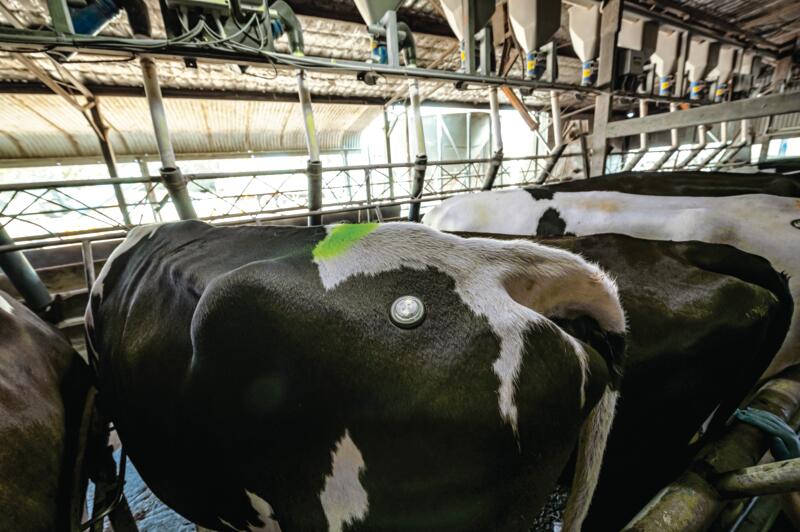 An electronic heat detector on one of the Holsteins. If it flashes green, it indicates the cow may be in-calf.
An electronic heat detector on one of the Holsteins. If it flashes green, it indicates the cow may be in-calf.
“We were calving every day of the year and we decided that for cows calving from about the end of December to the start of February, it was just too hot and humid for them and they were really crashing,” Luke says.
So they looked at batch calving and opted to start joining on the first day of February, with bulls running with the herd for about seven weeks. Luke says the heat detection units have made a perceptible difference because it’s easier to track whether cows are in calf.
A less high-tech method for monitoring joining is tail painting – marking cows’ flanks with paint that rubs off when they’re mounted – but Luke says this is highly inaccurate. “Cows can even just swish their tail to get flies off and it’ll rub the paint a bit and look like they’ve been mounted,” he says.
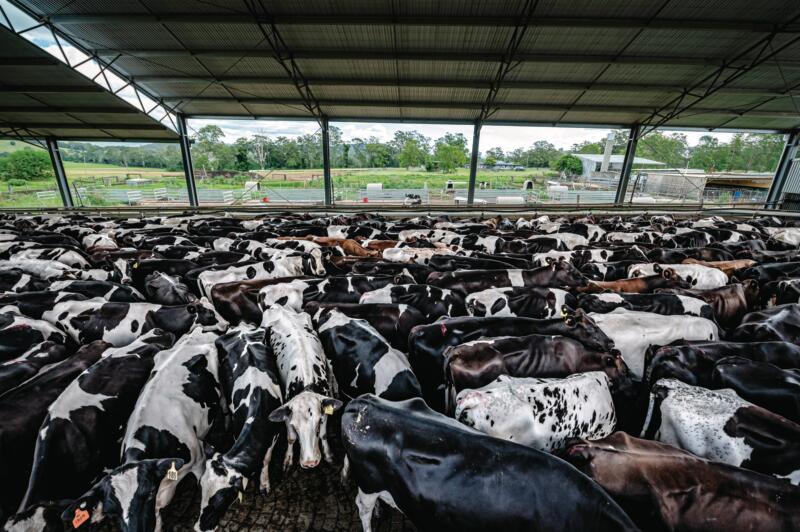 The cattle in the covered yard.
The cattle in the covered yard.
The heat detection units work by pressure and once there has been a certain number of jumps on the cow, the disc begins to flash red. “It won’t go off with just one [mount],” Luke says. “There has to be a few, so you hopefully won’t get a false heat.”
The Clearys then record the cow’s data in the computer to monitor likely in-calf and calving dates. Luke says pregnancy is never confirmed until the vet tests the cow, but it does give them a fairly accurate idea of when they’re due to calve.
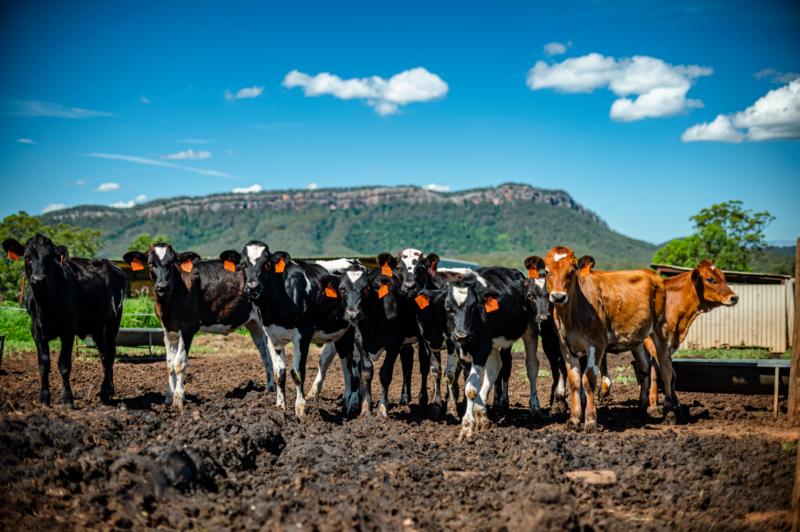 Some of the Holstein calves.
Some of the Holstein calves.
“If they don’t come back on heat after about 24 days [the unit] will flash green, which means they’re in-calf. And if not, of course, if they’re bulling [in heat] 21 days later, it’ll start flashing red again,” Luke says.
“It’s been really easy for anyone to just look and say, ‘Yep, she’s bulling’, because of this disc flashing at you, rather than looking at the tail paint and guessing if she’s been jumped. So it’s made it very black and white, if a red light can be counted as that.”
One drawback of the units is they sometimes fall off and have to be re-glued. That’s not a problem with the more robust and expensive rumination ‘smart’ collars that are also used to detect heat and predict pregnancy. The collars monitor body temperature and cow movement in the paddock and send data back to a central computer program that can trigger alarms if readings suggest a cow is sick.
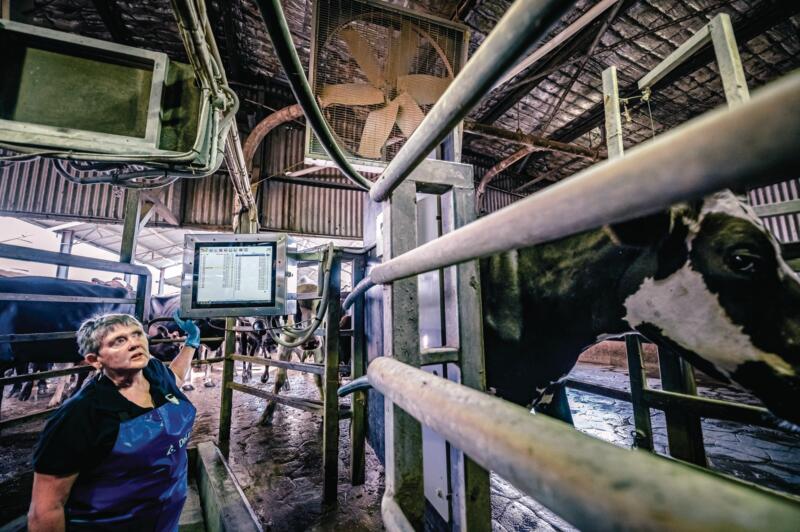 Sue Cleary with the statistics screen for the cows.
Sue Cleary with the statistics screen for the cows.
If there were endless pots of money, Luke says, the collars would be his next investment, but for now, the cost can’t be justified. “A box of about 200 lights is about $1,500. We’d go through a lot of boxes before we got to that $80,000 point, but of course once you bought the collars and the computer program that’d hopefully be all you ever spent on it.”
New technology developments always on farm’s radar
Robot milking is another technology development Luke is eyeing off. “It’s still nowhere near the speed a human can put cups on cows at this point, but of course once upon a time people put cars together by hand and you know there wouldn’t be too many to do that these days, it’s all computerised.”
He expects the technology will help farmers find and keep workers, but ultimately predicts that so many developments towards automation and robotics mean dairies will eventually need a different staff base. “I’m in two minds,” he says. “If that’s the way the whole world’s going, it means there’s a percentage of people out there now as farm workers who won’t be suited to this. But then I look at my nieces and nephews and the technology they can already grasp and it’s probably where most things will go.”
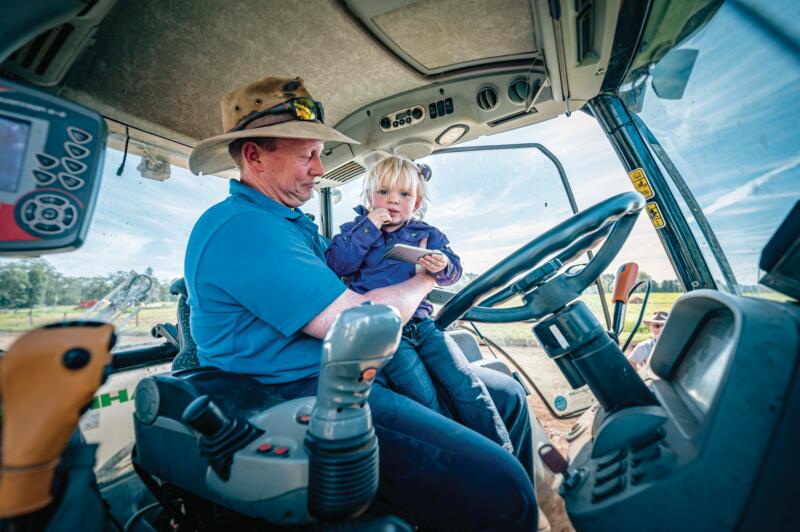 Luke Cleary and daughter Ruby in the tractor cab.
Luke Cleary and daughter Ruby in the tractor cab.
The Clearys employ two full-time staff and Luke says there are always various people coming in and milking at different times. Computerisation of the dairy, and data-driven feeding hasn’t just meant better outcomes for getting the right cows the right amount of feed at the right time in the calving cycle, it’s taken the guesswork out of animal care.
RELATED ARTICLES ON INNOVATION:
-
What makes a truly innovative farmer?
-
Oyster growers thrive in environmental crisis
-
Clever silo storage helps grain farmer
-
How alpaca farmers are owning their niche
“[The system] reads every cow as they come in and if there’s a mastitis cow or something treated for something else, it will tell you when you shut the gate at the end of the row. So you know which one’s milk can’t go into the vat, which one’s got to be on a bucket or whatever,” Luke says.
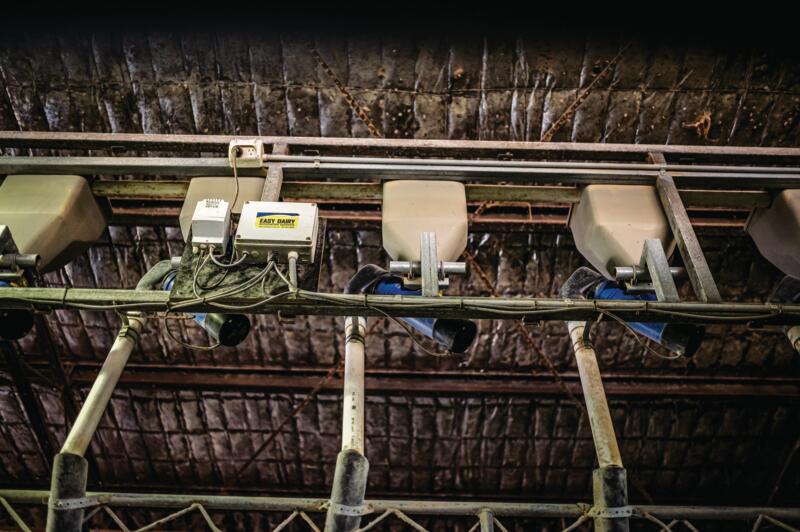 The feed system in the dairy at Hastings Park is linked to tags on the cows, which feed into a computer system that controls the amount of feed each cow gets.
The feed system in the dairy at Hastings Park is linked to tags on the cows, which feed into a computer system that controls the amount of feed each cow gets.
“It makes it fairly simple and straightforward and that’s the way the next generation is going of course. They all know how to use a smartphone and a computer.”
Netherlands leading the way in dairy innovation
When it comes to innovation in dairy farming, the Netherlands is sailing ahead. The world’s
first floating dairy farm was recently completed in Merwehaven harbour in Rotterdam. The high-tech 736sqm barge will house 40 cows in a “garden-like” environment.
The cows will live on the upper level of the two-deck structure, protected by a translucent roof that will harvest rainwater as well as sunlight via solar panels. Milking, feeding and manure collection will be performed by robots.
The lower ‘factory’ level includes water purifying and manure- and urine-processing plants, an area where feed will be grown under LED lights and a dairy processing plant producing pasteurised milk and yoghurt. Developers predict the farm will produce about 800 litres of milk a day.
The aim of the farm is to bring food production to the city, where the vast majority of consumers live and there is the greatest demand for fresh and healthy produce. It will also show off advances in farming technology and animal welfare.
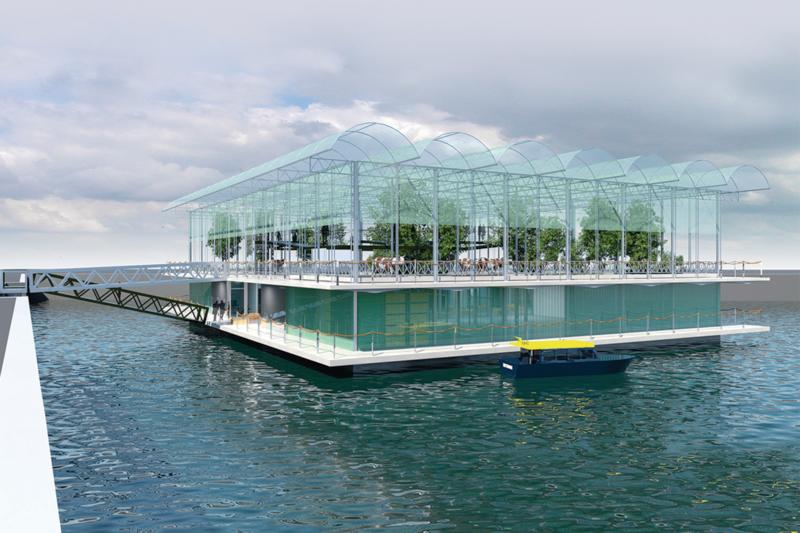 An artist’s conception of the floating dairy farm in Rotterdam.
An artist’s conception of the floating dairy farm in Rotterdam.
“To make urbanites more aware of healthy food, we want to bring the food production close to the consumer,” says a statement on the floating farm website. “We aim to make healthy food appealing in a transparent and educative way. The city farm shows food production is a clean and high-tech profession.”
Another bonus of having a farm in the centre of the city is reduced transport pollution as produce doesn’t have to travel so far from farm to consumer. The farm will recycle as much waste as possible, and most of the cows’ food will come from city waste products, such as grains left over from local breweries and by-products from mills. The project will even generate some of its own energy – hydrogen produced through electrolysis powered by solar panels.
If successful, the dairy could be followed by floating chicken farms and vertical farming greenhouses.
Check out the progress of the Floating Farm on their Instagram page: